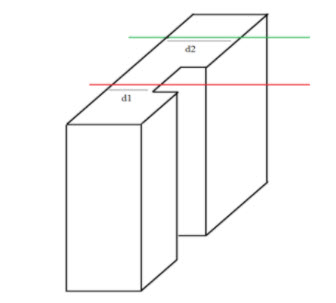Diffractive Optical Elements (DOEs) are flat, window-like optical components that are used to shape laser light. This article provides a brief review of DOE basics, how they operate, and what optical functions they can achieve
Diffractive Optical Elements (DOEs), sometimes referred to as digital diffractive optics, are phase relief elements that uses micro-structures to alter the phase of the light propagated through them, and thus manipulate it in various ways to create shapes and light patterns that are either impossible to achieve in different methods using refractive optics, or require very complex, bulky and expensive optical components and / or systems.

The important thing to know about diffractive optical element basics, is that due to its principle of operation, i.e. – the phase delay created by the micro structures, a DOE is designed for a discrete wavelength and is thus suitable for use mostly in laser systems (A source with narrow bandwidth around the nominal wavelength will work properly with minor deviations from the optimum).
Advantages of using Diffractive Optical Elements
The advantages system designers gain by integrating DOEs into their systems, where beam shaping or splitting is required, are:
- Perfect angular accuracy with no tolerances
- Flexible shaping and / or splitting capabilities with a single compact component – DOEs are flat, thin and lightweight.
- System robustness and low maintenance – DOEs are passive components with no electronics or mechanical moving parts (unlike other beam shaping solutions such as scanners or modules). Thanks to their production qualities, Holo/Or’s DOEs have a high laser damage threshold (LDT) similar to that of a window made of the same substrate (typically laser grade Fused-silica or Zinc-Selenide).
- Ease of integration – being a single flat component, DOEs are easily integrated into any opto-mechanics. They can be fabricated at standard or custom dimensions to fit manufacturers accurate system tolerances, or be used with standard optical mounts. Some DOE designs, such as top hat beam shapers, require accurate alignment tolerances, specifically centration and beam size.
Types of diffractive optical elements
Diffractive optical elements are used to generate various functions from a Gaussian input beam:
- Diffractive beam splitters – unlike other optical beam splitters, diffractive beam splitters are used to split an input laser beam into any desired number of identical output beams with the exact same characteristics and a controlled separation angle between them. These beams can be patterned into a 1 dimensional or 2 dimensional arranged array, a semi random dot pattern, a split beam with different intensity levels for beam sampling for example, or any other desired arrangement.
- Diffractive beam shaper – there are two types of diffractive beam shapers: the diffractive diffuser and the analytical top-hat diffractive beam shaper. Both beam shapers generate a flat top distribution of the energy on the work plane in any desired intensity profile shape (can be round, rectangle, or any freeform shape that can be mathematically described). Ring or donut shapes are also available with a diffractive axicon or a diffractive vortex lens.
The choice between using a diffractive diffuser or an analytical top hat diffractive beam shaper is typically done based on the laser source: the diffuser is typically used in multi-mode laser systems while the top hat beam shaper is typically used with a single-mode laser.
- Beam foci elements – unlike the two types of DOEs described above, beam foci elements manipulate the laser beam on the propagation axis. These types of elements can generate an elongated focus Bessel beam stretching the beam waist to many times the Rayleigh range, or generate multiple foci with controlled separations between them.
The beauty in diffractive optical element basics, is that with the right knowledge and tools, one can design a superposition of functions on the same surface and thus create a single element with multiple functionalities, for example – if your systems requires 5×5 square flat top spots – this can be achieved with a single surface, with no loss in efficiency.
The future of Diffractive Optical Elements
DOEs, powerful as they may be, are passive elements, a quality which is an advantage in many applications but poses a limitation for others. In many applications, the flexibility of creating various optical functions on the same optical path is an advantage DOEs lack.
To address this issue, Holo/Or has recently developed a new method for Adjustable Function Beam Shaping. These elements contain more than one optical function on the same surface but on different areas.
With these unique elements, mounted on a moving or rotating stage, or with an additional component to stir the input beam, one can design an active beam shaping system that enjoys all the great advantages of diffractive optics including quality, accuracy and compactness, while still enabling flexible shaping.
TL; DR - Q&A
Q: What are the diffractive optical element basics?
A: The basic thing to know about diffractive optical elements is that they use the wave nature of light to create phase delays and thus manipulate the beam shape. They therefore are mostly suitable for use in single wavelength laser systems.
Q: What are the advantages of Diffractive Optics?
A: Diffractive Optical Elements have perfect angular accuracy, they are flexible in their functionality, flat & compact, robust and easy to integrate into any opto-mechanics.
Q: What types of diffractive Optics are there?
A: basically any output function that can be mathematically described can be generated using diffractive optics, but the main ones are beam splitting, beam shaping and beam foci shaping.

